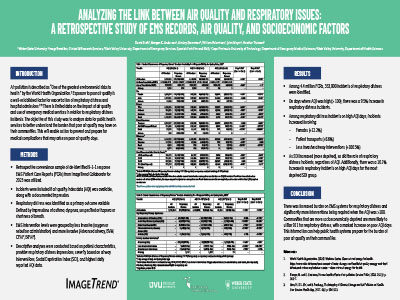ABSTRACTS
Analyzing the Link Between Air Quality and Respiratory Issues: A Retrospective Study of EMS Records, Air Quality, and Socioeconomic FactorsAuthor: Derek Kraft | | Associate Authors: Morgan K. Anderson, Ainsley Stoneman, William Robertson, John Meyer, Heather Thiesset
Introduction: Air pollution is described as “One of the greatest environmental risks to health.” by the World Health Organization. Exposure to poor air quality is a well-established factor for exacerbation of respiratory distress and hospital admissions. There is limited data on the impact of air quality and use of emergency medical services in relation to respiratory distress incidents. The objective of this study was to analyze data for public health services to better understand the burden that poor air quality may have on their communities. This will enable action to prevent and prepare for medical complications that may arise on poor air quality days. Methods: Retrospective convenience sample of de-identified 9-1-1 response EMS Patient Care Reports (PCRs) from ImageTrend Collaborate for 2023 was utilized. Incidents were included if air quality index data (AQI) was available, along with a documented impression. Respiratory distress was identified as a primary outcome variable. EMS intervention levels were grouped by less invasive (oxygen or nebulizer administration) and more invasive (Advanced airway, BVM, CPAP, BiPAP). Descriptive analyses were conducted based on patient characteristics, provider respiratory distress impressions, severity based on airway interventions, Social Deprivation Index (SDI), and highest daily reported AQI data. Results: Among 4.4 million PCRs, 353,000 incidents of respiratory distress were identified. On days where AQI was high (> 100), there was a 9.5% increase in respiratory distress incidents. Among respiratory distress incidents on high AQI days, incidents increased involving females (+12.2%), involving patient transports (+6.6%), and “less invasive” airway interventions (+106.5%). As SDI increased (more deprived), so did the rate of respiratory distress incidents, regardless of AQI. Additionally, there was a 16.7% increase in respiratory incidents on high AQI days for the most deprived SDI group. Conclusion: There was increased burden on EMS systems for respiratory distress and significantly more interventions being required when the AQI was >100. Communities that are more socioeconomically deprived are more likely to utilize 911 for respiratory distress, with a marked increase on poor AQI days. This information can help public health systems prepare for the burden of poor air quality on their communities.
|

